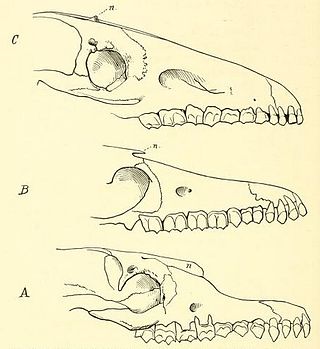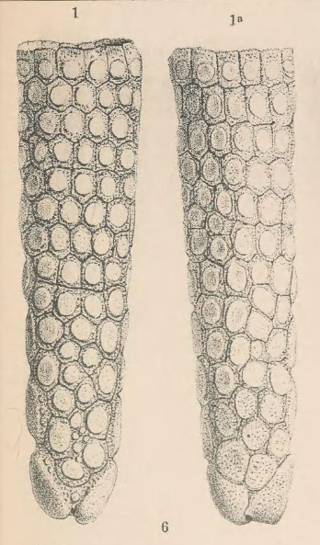Related Research Articles

Florentino Ameghino was an Argentine naturalist, paleontologist, anthropologist and zoologist, whose fossil discoveries on the Argentine Pampas, especially on Patagonia, rank with those made in the western United States during the late 19th century. Along with his two brothers – Carlos and Juan – Florentino Ameghino was one of the most important founding figures in South American paleontology.

Scalabrinitherium is an extinct genus of mammals of the family Macraucheniidae. Fossils of this animal were found among the fossils of prehistoric xenarthrans in the Ituzaingó Formation of Argentina.

Astrapotheria is an extinct order of South American and Antarctic hoofed mammals that existed from the late Paleocene to the Middle Miocene, 59 to 11.8 million years ago. Astrapotheres were large, rhinoceros-like animals and have been called one of the most bizarre orders of mammals with an enigmatic evolutionary history.
Henricosborniidae is a family of extinct notoungulate mammals known from the Late Paleocene to Middle Eocene of Argentina, Bolivia and Brazil. The name honors U.S. paleontologist Henry Fairfield Osborn.

Interatherium is an extinct genus of interatheriid notoungulate from the Early to Middle Miocene (Colhuehuapian-Mayoan). Fossils have been found in the Santa Cruz, Collón Curá and Sarmiento Formations in Argentina.

Patagornis is a genus of extinct flightless predatory birds of the family Phorusrhacidae. Known as "terror birds", these lived in what is now Argentina during the Early and Middle Miocene; the Santa Cruz Formation in Patagonia contains numerous specimens. Patagornis was an agile, medium sized Patagornithine and was likely a pursuit predator.
Cruschedula is an enigmatic bird genus considered to be nomen dubium which consists of the single species Cruschedula revola.

Necrolestes is an extinct genus of mammals, which lived during the Early Miocene in what is now Argentine Patagonia. It is the most recent known genus of Meridiolestida, an extinct group of mammals more closely related to therians than to monotremes, which were the dominant mammals in South America during the Late Cretaceous. It contains two species, N. patagonensis and N. mirabilis; the type species N. patagonensis was named by Florentino Ameghino in 1891 based on remains found by his brother, Carlos Ameghino in Patagonia. Fossils of Necrolestes have been found in the Sarmiento and Santa Cruz Formations. Its morphology suggests that it was a digging, subterranean-dwelling mole-like mammal that fed on invertebrates.

Neosclerocalyptus was an extinct genus of glyptodont that lived during the Pliocene, Pleistocene, and Holocene of Southern South America, mostly Argentina. It was small compared to many glyptodonts at only around 2 meters long and 360 kilograms.

Lomaphorus is a possibly dubious extinct genus of glyptodont that lived during the Pleistocene in eastern Argentina. Although many species have been referred, the genus itself is possibly dubious or synonymous with other glyptodonts like Neoslerocalyptus from the same region.
Promacrauchenia is an extinct genus of macraucheniids that lived during the Late Miocene to Late Pliocene epochs of what is now Argentina and Bolivia. It belongs to the subfamily Macraucheniinae, which also includes Huayqueriana, Macrauchenia, and Xenorhinotherium. Fossils of this genus have been found in the Ituzaingó, Andalhuala, and Cerro Azul Formations of Argentina.
Polymorphis is an extinct genus of litopterns belonging to the family Macraucheniidae. It lived during the Middle Eocene of Argentina.
Henricosbornia is an extinct genus of henricosborniid notoungulate that lived from the Late Paleocene to the Middle Eocene of what is now Argentina and Brazil.
Eohyrax is an extinct genus of notoungulate, belonging to the suborder Typotheria. It lived during the Middle Eocene, and its remains were discovered in South America.

Trachytherus is an extinct genus of mesotheriid notoungulate that lived from the Late Oligocene to the Early Miocene in what is now South America.

Isotemnus is an extinct genus of notoungulate belonging to the family Isotemnidae. It lived from the Late Paleocene to the Middle Eocene of what is now Argentina.
Colpodon is an extinct genus of herbivorous mammal, belonging to the order Notoungulata. It lived during the Early Miocene, in what is today Argentina and Chile, in South America.

Peltephilidae is a family of South American cingulates (armadillos) that lived for over 40 million years, but peaked in diversity towards the end of the Oligocene and beginning of the Miocene in what is now Argentina. They were exclusive to South America due to its geographic isolation at the time, one of many of the continent's strange endemic families. Peltephilids are one of the earliest known cingulates, diverging from the rest of Cingulata in the Early Eocene.
Liarthrus is a genus of astrapotheriid mammal known from the Late Oligocene Sarmiento Formation of Santa Cruz Province, Argentina. It was described by the Argentine paleontologist Florentino Ameghino in 1895 along with several other genera from the "Pyrotherium Beds", which were then believed to date to the Cretaceous period. Ameghino described Liarthus on the basis of fragmentary, being only a right astragalus, premolar 4, and an incomplete premolar from the upper jaws. Only one species was described, L. copei, the species name honoring the American paleontologist Edward Drinker Cope, who lived during the same interval as Ameghino. Liarthrus was synonymized with the other astrapothere Parastrapotherium in 1914 by American mammalogist Frederic Loomis, though it was revalidated by a 2008 analysis of Parastrapotherium. Liarthrus was a herbivorous mammal, being an astrapothere, which had large tusks on their skulls and mandibles in addition to a large body size.
Argyromanis is an extinct species of mammal of unknown affinities that lived in Argentina during the Miocene. It was described by prolific Argentine paleontologist Florentino Ameghino in 1904 on the basis of a single left astragalus that had been unearthed from the Santacrucian sediments of Santa Cruz, Argentina. Ameghino described it as a species of pangolin, even including this in the genus name's root -manis, after Manidae. The species name patagonica is after the fossil's discovery in Patagonia. However, later analyses of the astragalus have been inconclusive and find it to be an indeterminate genus of mammal.
References
- ↑ "Fossilworks: Orthoarthrus mixtus". www.fossilworks.org. Retrieved 2023-06-11.
- 1 2 Ameghino, Florentino (1904). "Nuevas especies de mamíferos, cretáceos y terciarios de la República Argentina". Anales de la Sociedad Cientifica Argentina. 56–58: 1–142.
- ↑ Vizcaíno, S. F., & Bargo, M. S. (2014). Loss of ancient diversity of xenarthrans and the value of protecting extant armadillos, sloths and anteaters. Edentata, 15(2014), 27–38.
- ↑ Mones, A. (1986). Palaeovertebrata Sudamericana.-Catálogo Sistemático de los Vertebrados Fósiles de America-del Sur-Parte I. Lista Preliminar y Bibliografía.
- ↑ Sharpe, D. (Ed.). (1912). Index Zoologicus No. II.: An Alphabetical List of Names of Genera and Subgenera Proposed for Use in Zoology as Recorded in the" Zoological Record," Vols. 38-47 Inclusive (1901-1910) and the Zoology Volumes of the" International Catalogue of Scientific Literature" Annual Issues 1-10, Together with Other Names Not Included in Previous Nomenclators (No. 2). Society.